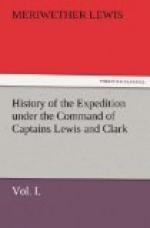south 30 degrees west. It is also more divided
and serpentine in its course than the other two, and
possesses more timber in its meadows. This timber
consists almost exclusively of the narrow-leafed cottonwood,
with an inter-mixture of box alder and sweet-willow,
the underbrush being thick and like that of the Missouri
lower down. A range of high mountains partially
covered with snow is seen at a considerable distance
running from south to west, and nearly all around
us are broken ridges of country like that below, through
which those united streams appear to have forced their
passage: after observing the country captain
Lewis descended to breakfast. We then left the
mouth of the southeast fork, to which in honour of
the secretary of the treasury we called Gallatin’s
river, and at the distance of half a mile reached
the confluence of the southwest and middle branch
of the Missouri. Here we found the letter from
captain Clarke, and as we agreed with him that the
direction of the southwest fork gave it a decided
preference over the others, we ascended that branch
of the river for a mile, and encamped in a level handsome
plain on the left: having advanced only seven
miles. Here we resolved to wait the return of
captain Clarke, and in the meantime make the necessary
celestial observations, as this seems an essential
point in the geography of the western world, and also
to recruit the men and air the baggage. It was
accordingly all unloaded and stowed away on shore.
Near the three forks we saw many collections of the
mud-nests of the small martin attached to the smooth
faces of the limestone rock, where they were sheltered
by projections of the rock above it: and in the
meadows were numbers of the duck or mallard with their
young, who are now nearly grown. The hunters
returned towards evening with six deer, three otter
and a muskrat; and had seen great numbers of antelopes,
and much sign of the beaver and elk.
During all last night captain Clarke had a high fever
and chills accompanied with great pain. He however
pursued his route eight miles to the middle branch,
where not finding any fresh Indian track he came down
it and joined us about three o’clock, very much
exhausted with fatigue and the violence of his fever.
Believing himself bilious he took a dose of Rush’s
pills, which we have always found sovereign in such
cases, and bathing the lower extremities in warm water.
We are now very anxious to see the Snake Indians.
After advancing for several hundred miles into this
wild and mountainous country, we may soon expect that
the game will abandon us. With no information
of the route we may be unable to find a passage across
the mountains when we reach the head of the river,
at least such a one as will lead us to the Columbia,
and even were we so fortunate as to find a branch of
that river, the timber which we have hitherto seen
in these mountains does not promise us any fit to
make canoes, so that our chief dependence is on meeting
some tribe from whom we may procure horses. Our
consolation is, that this southwest branch can scarcely
head with any other river than the Columbia, and that
if any nation of Indians can live in the mountains
we are able to endure as much as they, and have even
better means of procuring subsistence.




